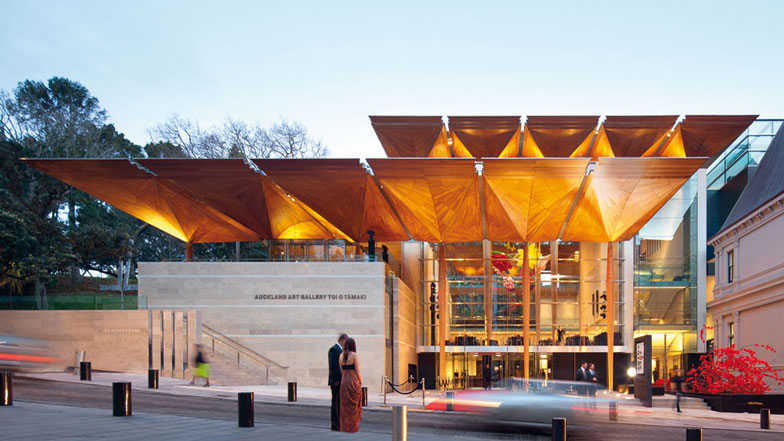I have been struggling for some time with the idea that much of today's architecture which strikes the casual viewer as arbitrary in form, is in fact no less rational than the stripped down international style boxes of the mid 20th century. Of course, fundamental to this proposition is that 'rational' does not denote any particular privileged truth, but merely means that something is derived by logical steps from a starting point taken as axiomatic.
I was reminded of this by two separate but related experiences in my work with residential flat buildings (better known in the rest of the world as 'apartments'). The first was coming across a press release promoting a particular Melbourne development. I quote:
My second experience of the day came at a project coordination meeting, where one issue discussed was the prescribed minimum ceiling height in our local regulations. It became quickly apparent that both the developer and the architects considered the floor to floor heights assumed by the planning authorities to be a serious constraint on the total amount of space they could fit into an allowable building envelope. Yet they also expected to be able to alter the arrangement of individual apartments at will, after planning approval is granted.
When arranging a floor plan, there are certain elements like the elevators, that insist on lining up vertically. More subtle is the influence of plumbing. If you don't line up your wet areas vertically above each other, there will be floor waste and shower traps, and possibly unwelcome horizontal waste pipes to be accommodated within the ceiling zone of the storey below. Quite apart from the unpleasant experience of the sound effects of someone's ablutions while you are perhaps sitting in your dining room, to accommodate such pipework requires additional space which minimum floor to floor heights do not allow. That is why the authorities insist that planning permission be based on assumptions of greater storey heights. All up, the discussion reminded me that even with flat floor plates, it isn't altogether a free-for-all when it comes to planning out the apartments.
Still, the net result is that there is no particular tyranny which requires any strict repetition between floors – or certainly not one that constrains the exterior expression of the successive layers of terraces. What appears at first sight in the Melbourne project to be a gratuitous superimposition of irrelevant metaphor in the design development, turns out to be clear-sighted, rational exploitation of the potential expression of the discipline of form. Arguably more so than the ascetic aesthetics of early modernism.
Of course, this begs the question of whether there are other constraints, that should become the parameters to which these new, freer forms should respond. It is the relative weakness of many architects, in identifying the contextual and environmental factors that logically constitute such constraints, that often offends.
I was reminded of this by two separate but related experiences in my work with residential flat buildings (better known in the rest of the world as 'apartments'). The first was coming across a press release promoting a particular Melbourne development. I quote:
"With extended frontage to the river, Sanctuary features a striking exterior that is inspired by a wind-blown spiral of autumn leaves. The angular balustrades on the facade are composed of both solid and glazed elements that alternatively reveal and conceal the building behind, in response to the movement around the building. This orchestrated pattern, at first seemingly random, gives the architecture a subtle complexity."However truthfully it might report the thinking of the designer, in fact the first sentence is a distraction. The essence of the design process for an apartment building is the 'flat plate' concrete structural solution, that became the dominant construction method for this building type in Australia in the 1970s. By adding only slightly to the thickness of the concrete slabs, engineers were able to accommodate the additional reinforcing steel to resist shear at the columns and thereby eliminate beams. This approach provides a completely flat soffit, under which walls could be arranged in almost any pattern, without having to pay regard to beams or column heads. The columns are not constrained into any particular regular grid, and the edges can cantilever within a certain range. Those cantilevers can also be be extended by up-turned or down-turned edge beams.
My second experience of the day came at a project coordination meeting, where one issue discussed was the prescribed minimum ceiling height in our local regulations. It became quickly apparent that both the developer and the architects considered the floor to floor heights assumed by the planning authorities to be a serious constraint on the total amount of space they could fit into an allowable building envelope. Yet they also expected to be able to alter the arrangement of individual apartments at will, after planning approval is granted.
When arranging a floor plan, there are certain elements like the elevators, that insist on lining up vertically. More subtle is the influence of plumbing. If you don't line up your wet areas vertically above each other, there will be floor waste and shower traps, and possibly unwelcome horizontal waste pipes to be accommodated within the ceiling zone of the storey below. Quite apart from the unpleasant experience of the sound effects of someone's ablutions while you are perhaps sitting in your dining room, to accommodate such pipework requires additional space which minimum floor to floor heights do not allow. That is why the authorities insist that planning permission be based on assumptions of greater storey heights. All up, the discussion reminded me that even with flat floor plates, it isn't altogether a free-for-all when it comes to planning out the apartments.
Still, the net result is that there is no particular tyranny which requires any strict repetition between floors – or certainly not one that constrains the exterior expression of the successive layers of terraces. What appears at first sight in the Melbourne project to be a gratuitous superimposition of irrelevant metaphor in the design development, turns out to be clear-sighted, rational exploitation of the potential expression of the discipline of form. Arguably more so than the ascetic aesthetics of early modernism.
Of course, this begs the question of whether there are other constraints, that should become the parameters to which these new, freer forms should respond. It is the relative weakness of many architects, in identifying the contextual and environmental factors that logically constitute such constraints, that often offends.













